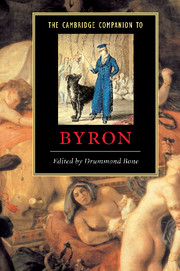1 - Byron's life and his biographers
from Part 1 - Historical Contexts
Published online by Cambridge University Press: 28 May 2006
Summary
Introduction
After the mid-nineteenth century, it became a stereotype that asylum inmates imagined themselves as the omnipotent Napoleon - but also the brilliant Byron. Extreme as it seems, this desire for vicarious experience, this tendency to translate one's life into the idealization of another, is common - so common that it led Albert Camus to define biography itself as 'nostalgia for other people's lives'. Camus notes that our fascination with the careers of the famous stems from our belief that such lives have strong plots, while our own seem fragmentary and directionless. However, since even the careers of celebrities are not as neatly plotted as we could wish, the production of that 'nostalgia' has required an unholy alliance between fiction and biography. Lord Byron knew this as well as perhaps anyone in history. In writing his own story and seeming to live what he wrote, he made it impossible to discuss his work apart from his life. The vignettes and anecdotes he relished and promulgated produced a tale unified around themes of sex, violence, genius, and adventure, or - in the case of hostile biographers - sex, violence, cruelty, and hypocrisy. But in either case, the indivisibility of the life and work explains much of the delight and frustration to be found in the immense canon of Byron Biography, everything from laurel wreaths to slash-and-burn character assassination, from factual accounts to encounters beyond the grave, such as Quevedo Redivivus's A Spiritual Interview with Lord Byron (1840) and Amanda Prantera's Conversations with Lord Byron on Perversion, 163 Years after His Lordship's Death (1987).
- Type
- Chapter
- Information
- The Cambridge Companion to Byron , pp. 7 - 26Publisher: Cambridge University PressPrint publication year: 2004
- 2
- Cited by



